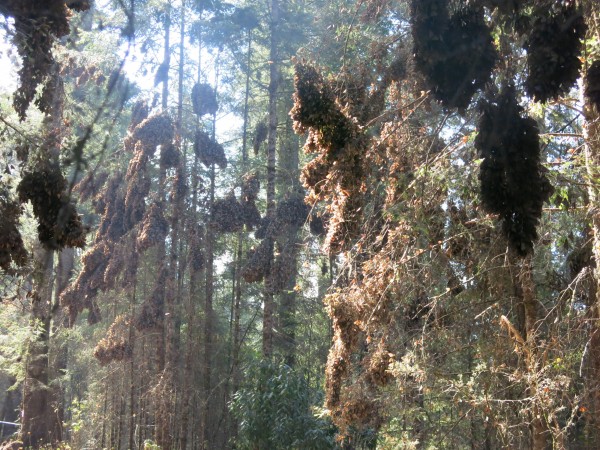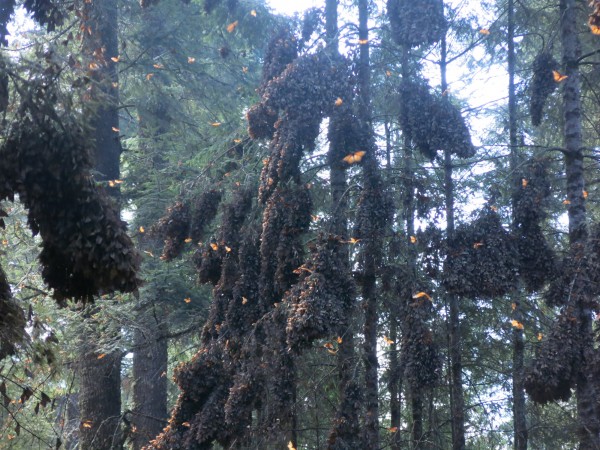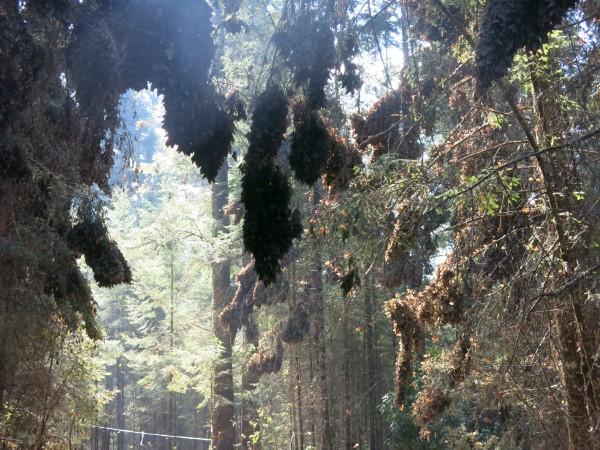Why Late Departure?
Dr. Chip Taylor of Monarch Watch shared his insights:
Monarchs continue to surprise. Estela Romero, who works extensively with Journey North, reported on Tuesday (3 April) that there were still 30 trees festooned with large clusters of monarchs at El Rosario. See Estela’s first hand account.
Subsequent reports indicated that most of those monarchs left the colony that afternoon. On Friday, two visitors to El Rosario independently sent notes indicating that small clusters were still present on 4 trees.
Monarchs typically abandon all the overwintering sites by the last week of March and while some clusters have been reported as late as 1 April in the past, the sighting of 30 trees covered with dense clusters this late in the season is outside of the experience of those who have worked with monarchs for decades.
Since the number of trees covered with monarchs at El Rosario was much lower earlier in the first 10 days of the month, there has been some speculation as to the origin of these monarchs. My guess is that they came from other known colonies, but the fact is, we really don’t know.
This event raises lots of issues about the nature of the monarchs that remain (size, sex, mass, general condition, origins, etc.) as well as whether there is any chance these 10s of thousands of monarchs have any likelihood of reaching the milkweed areas of coastal and inland Texas.
If you have been following any of my posts for the last five weeks, you may recall that I have been trying to scope out the paths monarchs take as they move north through Mexico. In the process, I’m learning how to use Google Earth to mark pathways and calculate distances. I’m going to have to save a lot of the detail for an article in the Blog, but for now, let me tell you that we have been grossly underestimating the distances monarchs have to travel from the overwintering sites to the milkweeds areas in Texas. In the past, most of us who have written about the distances from the US to the overwintering sites, or the converse, have thrown around numbers like 500-600 miles - the straight line between two points sort of thinking. The distances are greater. There appear to be two paths by which monarchs reach Texas, a coastal route and an interior, mountain (higher ground) hugging, route that swings northwest such that monarchs enter Texas several hundred miles west of the coastal route. The coastal route is shorter, but is still well over 700 miles while the interior route is over 800 miles. Further, even these distances are underestimates since monarchs don’t fly in straight lines from point to point. Interestingly, it appears that the coastal route isn’t always available since much of the area involves lowlands with daytime temperatures in the 80s and 90s and, late in the season (April), the 100s. Monarchs don’t migrate at those temperatures and they preferentially seek out temperatures in the 60s and low 70s which keeps them in the highlands when the temperatures in the lowlands reach the 80s and higher.
So, what will the monarchs do that left El Rosario on the afternoon of the 3rd and how long will it take them to reach the milkweed areas of Texas. I’ve been saying that the trip from Mexico to the US takes 10-12 days. Given the distances, I’ll bet that’s wrong. It’s more likely to be 14-16 days and could be longer if they encounter, extreme weather conditions such as cold or hot conditions, strong headwinds, or rain. Will any of these monarchs reach the US? I don’t know, but the chances are diminishing. Over most of the next 10 days the coastal route will be “blocked” by high temperatures. It looks like returning monarchs will be forced to take the interior route and while the temperatures in the mountains from southwest of Cuidad Victoria will be moderate as monarch move toward Monterrey, once past that city high temperatures and dry conditions could limit the ability of monarchs to reach the US through this route as well.
Another unknown has to do with the mortality that occurs during this traverse from the overwintering sites to Texas. It’s likely that mortality varies from year to year during this passage and that could be a factor that influences how the population develops during the growing season.




